History of the BMW Roadster 1934-2010

BMW announced their first roadster in 1934. This first concept, with its six-cylinder power and two-seater body, started a model line that extends all the way to the latest BMW Z4.
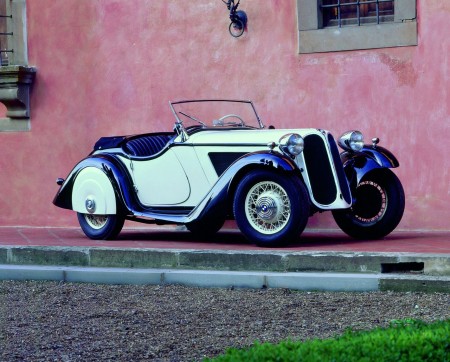
BMW 315/1 Roadster
The starting point for this development came at the Berlin Motor Show in May 1934. Here, together with the BMW 315 Saloon, BMW for the first time presented the prototype of a Sports Roadster. Right behind the long and sleek engine compartment there were two sports seats tailored to the driver and front passenger protected by the low, raked windscreen and an emergency roof.
The rear end tapered out in an elegant sweep to the back of the car, adding a particular aerodynamic touch with excellent streamlining.
The radiator grille on this two-seater was inclined much further to the rear than on the Saloon, with mighty, sweeping front wheel arches extending on beneath the doors into the rear wheel arches. To reduce air drag to a minimum, the rear wheels were fully covered, while the body of the car itself rested on an electrically welded steel-pipe double frame with three crosswise box elements.
Front suspension was made up of the upper track spring, wishbones further down and hydraulic lever-type dampers. The rear wheels, in turn, were mounted on a live axle incorporating semi-elliptic springs and hydraulic lever-type dampers.
Both the saloon and the sports car were powered by the same outstanding engine: a 1.5L straight-six developed out of the 1.2L originally featured in the former BMW 303. The crankcase and cylinder block were made of one single piece, the engine featured one camshaft beneath the block, with tappets operating the vertical hanging valves aligned in series via rocker arms. The intake and exhaust pipes, finally, were on the same side.
A feature quite unusual today is the different distances between the individual cylinders, with the second and third and, respectively, the fourth and fifth cylinders being further apart, the space in between being used for the crankshaft and camshaft bearings.
The crankshaft without any counterweights therefore ran in four bearings, just like the camshaft. This was however not the reason for this particular design and configuration, which was rather attributable to the assembly process at the time, with the crankshaft being completely pre-assembled together with the connecting rods and pistons. And since the pistons, as a result, had to be inserted from beneath, the main bearings for the crankshaft had to remain outside of the cylinders, not extending into their contour lines. As a result, the main bearings had to be accommodated between cylinders spaced out at a large distance.
While this power unit delivered maximum output of 34 hp on the saloon with its two carburettors, maximum output of the six-cylinder in the BMW 315/1 sports model was 40 hp. And the standard of efficiency offered was quite exceptional. BMW’s engineers proudly stated that in terms of running costs, it is no more expensive than a small car far lower down in the market.
With the public simply falling in love with the BMW 315/1, BMW decided to build the car in a small series – also because the Company wanted to make a more powerful entry into the prestigious world of motorsport. Starting in summer 1934, therefore, the very attractive BMW 315/1 was retailed at a substantial price. The production model differed from the prototype primarily through the modified arrangement of the headlights and side ventilation grids taking the place of the bent openings originally featured on the first model.
Reaching a top speed of 75 mph, the BMW 315/1 Roadster was one of the really serious contenders in the sports car market at its time. Indeed, BMW’s story of success on the race track quickly took on even greater significance with this new model, the BMW 315/1 achieving its first significant success in the International 1934 Alpine Rally.
The starter grid for this rally in Nice was made up of 127 truly outstanding cars looking at daily race sections of about 350 miles to be covered at a minimum speed. On the fourth day there was an additional speed test at Stilfser Joch.
After covering precisely 1,778 miles, 96 of the 127 cars which had originally entered the race reached the finish line in Munich – 66 thereof without having lost one point. The five cars entered by the BMW Works Team were the only cars in their class to complete the International Alpine Trophy without one single penalty point, with the BMW 315/1 Team finishing first in their category.
Only 230 units of the BMW 315/1 were completed by mid-1935, many of them going to private drivers. One of them was Ralph Roese, a BMW works driver for many years, who built himself a BMW 315/1 Special. This was a complete re-build of the 315/1, the highly modified engine ultimately developing no less than 136 hp in a brand-new race car body weighing just 838 lbs.
Given qualities of this kind, it is no surprise that this racing car finished first in its very first race at Nürburgring in 1936, a staggering 10 miless ahead of the competition. Understandably, this special model remained a great success over the years until finally winning the German Road Racing Championship in 1939.
Achieving this kind of success, both the drivers and the Company soon started looking for more: a car in the prestigious category up to two liters. And so it is no surprise that another, even more powerful version of the BMW Roadster, dubbed the 319/1, entered the market in late 1934. Identical in its looks to the BMW 315/1 with the exception of the air vent on the engine compartment, the BMW 319/1 was powered by a 1.9L tuned to 55 hp and benefiting both from larger displacement and three larger downdraft carburetors.
Obviously, an engine like this was easily able to cope with a two-seater weighing just 1716 lbs, accelerating the roadster in standard trim to a top speed of approximately 84 mph. At the same time this was of course a truly exclusive car due to its high retail price. Production from 1934-1936 therefore amounted to just 178 units, with the BMW 319/1 again bringing home outstanding success in motorsport.
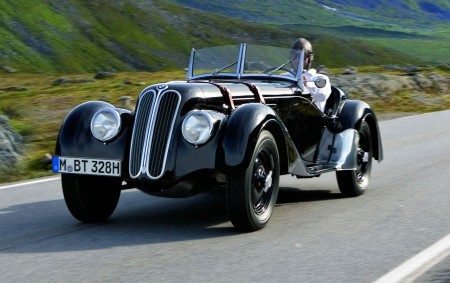
BMW 328 Roadster
In the mid-1930s, production roadsters and competition cars were still very similar in technical terms – and motorsport was still the ideal place to prove the performance and reliability of a production car. But to keep up with the competition, BMW soon had to build cars with more power and muscle. So BMW’s engineers looked for ways and means to significantly increase engine output without increasing engine size. And they found the solution – the M328, the engine powering the legendary BMW 328 sports car in 1936.
Right from the start in its debut at Nürburgring on 14 June 1936, BMW’s new roadster literally pulverized even the most powerful supercharged competitors. This outstanding success was attributable to the well-balanced combination of superior engine power and cutting-edge suspension technology characteristic of BMW roadsters to this day – 80 hp in the regular version and low weight of just 1830 lbs gave this elegant roadster superior performance still impressive today.
With the BMW 328 Roadster initially being restricted to motorsport as of mid-1936, production of the series model started in spring 1937. And so this high-performance sports car was driven not only by BMW’s works drivers, but also by private customers since, over and above racing, it was very well suited for everyday use. And with its top speed of 96 mph, this was indeed one of the fastest cars on the road back then.
But again, the BMW 328 Roadster remained a very rare bird, with only 464 units of this classic roadster being built up to 1940.
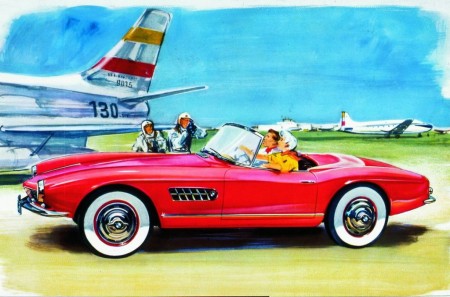
BMW 507
While the 328 paved the way for BMW’s sporting activities, the Company’s next two-seater sports car set new standards in design and elegance as of the mid-50s: the BMW 507.
When making its debut in New York in 1955 the 507 left both journalists and the public absolutely spellbound. The long and sleek engine compartment, the cockpit perfectly tailored to the driver and passenger, the short and muscular rear end, stretched side lines and gently sweeping curves gave the car absolutely beautiful, timeless design.
At the same time the 507 came with a brand-new BMW face. The double kidney grille was now vertical instead of horizontal, sweeping elegantly between the headlights across the entire front end of the car. And the 507 also had a lot to offer within the engine compartment, boasting an aluminum V8 acknowledged to this day as the first light-alloy V8 in the world built in series production.
Finished in brilliant red, the sales brochure proudly presenting BMW’s new eight-cylinder sports car promised truly outstanding performance: 150 hp from a 3.2L engine and a top speed of 136 mph. And as an option BMW somewhat later also offered an upgraded version, delivering approximately 165 hp maximum output.
This truly exclusive car went to exactly 251 proud owners between 1956 and 1959. And not all of them wanted to enjoy this beauty merely as a café cruiser, racing driver and the “King of Hill-Climbing” Hans Stuck using a modified 507 in mountain races in Europe and winning a number of events in his eight-cylinder roadster.
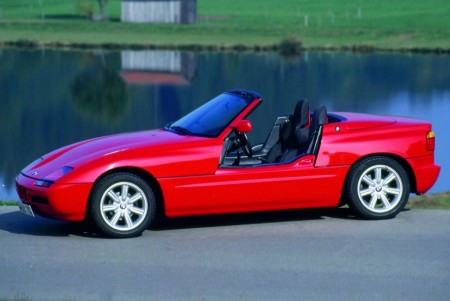
BMW Z1
With the roadster coming under increasing criticism in the ’60s and ’70s in terms of both safety and comfort, it took 29 years before the next roadster bearing the white-and-blue logo entered the market. This was the BMW Z1 launched – ahead of its time in technical terms – in 1988.
The body of the Z1 was a steel monocoque made of pressed and welded metal panels and with its plastic floor bonded into place. The entire outer skin was made up of plastic elements and panels likewise bolted on to the car, with the doors retracting on request into the high side-sills even while driving.
The 170-horsepower 2.5L straight-six power unit and most of the car’s axle components came from the 3 Series. With the engine being fitted behind the front axle, the BMW Z1 was a front mid-engined car, to use the technical term.
Acceleration from a standstill to 100 kph came in less than eight seconds and the car’s top speed was 140 mph.
Through its extremely harmonious combination of materials and technologies, the BMW Z1, weighing just 2756 lb, was a truly dynamic roadster still thrilling today in terms of stiffness, its low center of gravity, and stability in bends. The first units of the car built largely by hand were delivered to customers as of January 1989 at a high base price, ensuring lasting exclusivity. Production of the BMW Z1 finally ended in June 1991, after a production run of exactly 8,000 units.
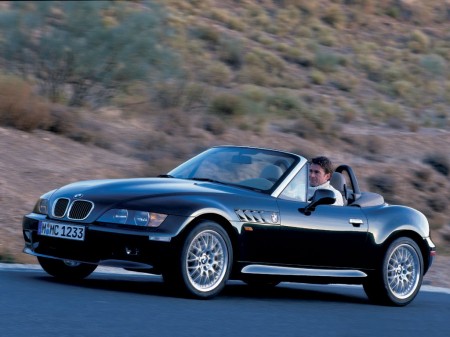
BMW Z3
The BMW Z1 was the breakthrough. More and more enthusiasts now showed growing interest in an open BMW two-seater – and in response BMW launched a roadster in 1995 built in large numbers for customers the world over. Very soon this compact performer became the epitome of BMW’s classic virtues, offering well-balanced technology within a truly attractive body and with a clear focus on driving pleasure.
The BMW Z3 entered the market with a choice of two engines. Featuring a 1.8L four-cylinder two-valve power unit developing maximum output of 115 hp, the “regular” model accelerated to 60 mph in 9.5 seconds and reached a top speed of 120 mph. The other option was a four-valve 1.9L four-cylinder delivering maximum output of 140 hp for acceleration to 60 mph in 8.5 seconds and a top speed of 127 mph.
With the Z3 proving to be a huge success, BMW was able in the course of time to offer a whole range of different engines meeting all kinds of different demands. Ultimately, therefore, the portfolio extended from the original 1.8L four-cylinder all the way to the 3.2L six-cylinder high-performance power unit carried over from the BMW M3, delivering up to 325 hp in the M Roadster and giving BMW’s compact sports car truly outstanding performance on the road.
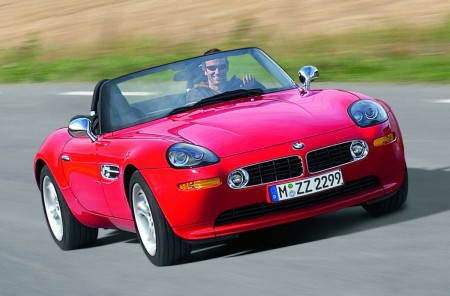
BMW Z8
Entering the new millennium, BMW proudly presented a very special new model: the BMW Z8. With its sleek proportions, classic lines and soft folding roof, the Z8 was truly one of the most outstanding cars of its time through its looks alone. It was indeed a modern interpretation of the former BMW 507.
Like its classic role model, BMW’s new roadster offered the very best technology available at the time in automobile production. Within the outer skin bolted on to the car, a monocoque aluminum frame, that is spaceframe technology, provided the load-bearing structure and gave the driver and passenger an extremely direct feeling of the road and the driving experience.
Within its engine compartment the BMW Z8 featured a high-performance 5.0L V8 sports engine delivering no less than 400 hp. Combined with a manual six-speed gearbox, this supreme engine enabled the driver to enjoy the utmost in performance at all times and under all conditions. Indeed, this superiority translated into equally clear facts and figures, the ambitious driver being able to lap the 20-km Nord-schleife of Nürburgring in the Z8 in a remarkable 8:15 minutes.
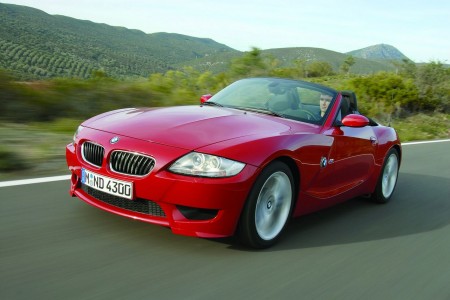
BMW Z4
The latest member of the BMW roadster family is the BMW Z4 presented for the first time at the Paris Motor Show in September 2002. From the start, this open two-seater not only marked a further highlight in BMW design language, but also set new standards in its class. The exciting design of the car was determined by the highly attractive interplay of convex and concave surfaces, hard edges and smooth, sweeping curves.
Available from the start with a choice of two high-torque straight-six power units, the Z4 – either in the guise of the 231 hp Z4 3.0i or as the 192 hp Z4 2.5i – guaranteed roadster motoring at its best.
The outstanding agility of the BMW Z4 is ensured by the car’s wide track, an extremely low center of gravity, optimum 50:50 axle load distribution, and the very precise electric power steering. Fading-free high-performance brakes, runflat tires featured as standard, and Dynamic Stability Control (DSC III) with an add-on traction mode finally, guaranteed supreme driving safety under all conditions.
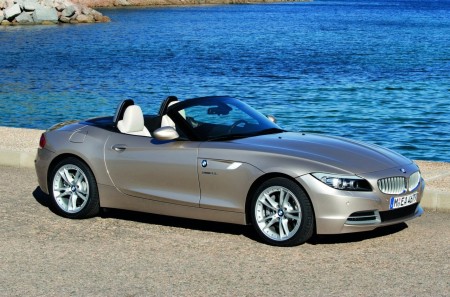
New BMW Z4
The modern interpretation of the classic roadster launched in spring 2009, the new BMW Z4, combines more power with more style than ever before. Indeed, this is the only car in its segment to combine classic roadster proportions with the seating position moved far back close to the rear axle, rear-wheel drive and a fully automatic retractable hardtop.
The new BMW Z4 offers all the driving pleasure of a BMW roadster in particularly refined style. Driving with the roof down, this outstanding two-seater provides a refreshing experience of the sun shining in and the wind rushing by, with the hardtop closed it ensures the same level of all-round comfort as a sporting coupé in the premium segment. So through its wide range of diverse qualities alone, the new BMW Z4 is indeed the re-birth of the roadster.
Here again, it is certainly appropriate to quote the “BMW Blätter”, the original BMW Leaflets in their description of the BMW 315/1 back in 1934: “In a nutshell you can describe BMW’s new sports car as the fast, beautiful and reliable car bound to give the ambitious sports driver one exhilarating experience after the other, at the same time combining all the advantages of an economical touring car.”
One Response to 'History of the BMW Roadster 1934-2010'
Subscribe to comments with RSS



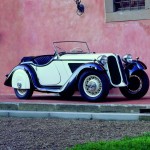
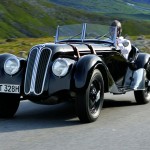
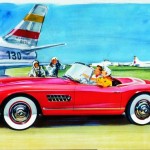
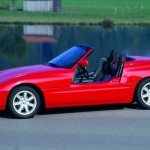
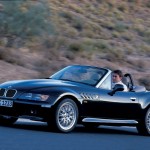
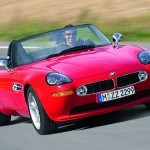
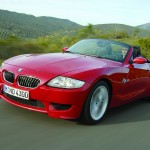
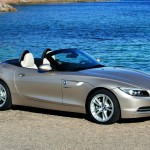
Gday Does anyone else love BMW’s as much as me?This past May, I bohgut a used BMW Z3 roadster, and totally love it. BMW is honestly the most impressive brand name vehicles you can buy. I will always purchase BMW’s from now on, but I must still say I like the older design a lot better than the modern designs. The older versions (really anything from 03,04 in some models back) look natural german. The newer versions look a lot more like japan makes, but nevertheless, they are simply remarkable. Many thanks Bob
Hrithik
3 Jan 13 at 8:17 am